
ColecoVision is a second-generation home video-game console developed by Coleco and launched in North America in August 1982. It was released a year later in Europe by CBS Electronics as the CBS ColecoVision.

Zaxxon is a scrolling shooter developed and released by Sega as an arcade video game in 1982. The player pilots a ship through heavily defended space fortresses. Japanese electronics company Ikegami Tsushinki was also involved in the game's development.
Spectravideo International Limited (SVI) was an American computer manufacturer and software house. It was originally called SpectraVision, a company founded by Harry Fox in 1981. The company produced video games and other software for the VIC-20 home computer, the Atari 2600 home video game console, and its CompuMate peripheral. Some of their own computers were compatible with the Microsoft MSX or the IBM PC.

Choplifter is a military-themed scrolling shooter developed by Dan Gorlin for the Apple II and published by Broderbund in 1982. It was ported to the Atari 8-bit computers the same year, and also to the VIC-20, Commodore 64, Atari 5200, ColecoVision, MSX, and Thomson computers.

B.C. II: Grog's Revenge is a 1984 video game by Sydney Development for the Commodore 64, ColecoVision, Coleco ADAM, and MSX. It is the sequel to B.C.'s Quest For Tires and is based on B.C., the newspaper comic strip by Johnny Hart. The game was advertised for the Atari 8-bit computers, ZX Spectrum, BBC Micro, and Amstrad CPC, but those ports were never released.

B.C.'s Quest for Tires is a horizontally scrolling video game designed by Rick Banks and Michael Bate and published by Sierra On-Line in 1983. Versions were released for the Commodore 64, IBM PC, Atari 8-bit computers, ColecoVision, ZX Spectrum, MSX, and Apple II. Based on the comic strip B.C. by Johnny Hart, BC's Quest for Tires is similar to Irem's Moon Patrol from the previous year. A wheel-riding caveman is always moving forward through horizontally scrolling levels, and the player jumps or ducks as obstacles approach. The game's title is a play on the contemporaneous film Quest for Fire.
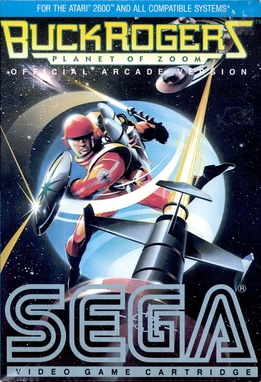
Buck Rogers: Planet of Zoom, known as Zoom 909 in Japan, is a pseudo-3D rail shooter released as an arcade video game by Sega in 1982. The player controls a spaceship in a third-person perspective, adapting the three-dimensional perspective of Sega's earlier racing game Turbo (1981) for the space shoot 'em up genre. It uses the Buck Rogers license, referencing the space battles, though Buck himself is never seen.
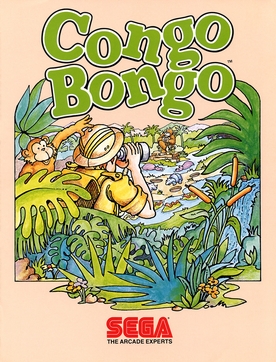
Congo Bongo, also known as Tip Top, is a platform game released as an arcade video game by Sega in 1983. A message in the ROM indicates it was coded at least in part by the company Ikegami Tsushinki. The game is viewed in an isometric perspective, like Sega's earlier Zaxxon (1982), but does not scroll. Numerous home ports followed.

Mr. Do! is a 1982 maze video game developed by Universal. It is the first arcade video game to be released as a conversion kit for other cabinets; Taito published the conversion kit in Japan. The game was inspired by Namco's Dig Dug released earlier in 1982. Mr. Do! was a commercial success in Japan and North America, selling 30,000 arcade units in the US, and it was followed by several arcade sequels.

Mr. Do's Castle is a platform game released in arcades by Universal in September 1983. In Japan, the game is titled Mr. Do! versus Unicorns. Marketed as a sequel to the original Mr. Do! released one year earlier, the game bears a far closer resemblance to Universal's Space Panic from 1980. It began as a game called Knights vs. Unicorns, but the U.S. division of Universal persuaded the Japanese arm to modify the graphics into a Mr. Do! game following the first game's popularity.

H.E.R.O. is a video game designed by John Van Ryzin and published by Activision for the Atari 2600 in March 1984. The game has players control Roderick Hero who traverses a mineshaft avoiding enemies and hazards to rescue trapped miners. He travels through the mines equipped with a hoverpack that allows him to traverse the game levels as well as bombs and laser that let him destroy walls and defeat enemies respectively.

Antarctic Adventure is a video game developed by Konami in 1983 for the MSX, and later for video game consoles, such as the Family Computer and ColecoVision. The player takes the role of an Antarctic penguin, racing to various research stations owned by different countries in Antarctica.

Beamrider is a fixed shooter written for the Intellivision by David Rolfe and published by Activision in 1983. The game was ported to the Atari 2600, Atari 5200, Atari 8-bit computers, ColecoVision, Commodore 64, ZX Spectrum, and MSX.
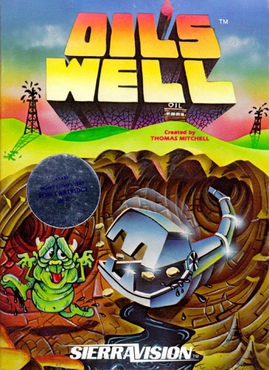
Oil's Well is a video game published by Sierra On-Line in 1983. The game was written for the Atari 8-bit computers by Thomas J. Mitchell. Oil's Well is similar to the 1982 arcade game Anteater, re-themed to be about drilling for oil instead of a hungry insectivore. Ports were released in 1983 for the Apple II and Commodore 64, in 1984 for ColecoVision and the IBM PC, then in 1985 for MSX and the Sharp X1. A version with improved visuals and without Mitchell's involvement was released for MS-DOS in 1990.

Frogger II: ThreeeDeep! is a video game released in 1984 by Parker Brothers for the Apple II, Atari 8-bit computers, Atari 2600, Atari 5200, ColecoVision, Commodore 64, and IBM PC compatibles. It is a sequel to the 1981 Konami Frogger arcade video game and has similar gameplay.

Gateway to Apshai is an action-adventure game for the Commodore 64, ColecoVision and Atari 8-bit computers. It was developed by The Connelley Group and published by Epyx in 1983 as a prequel to Temple of Apshai. It is a more action-oriented version of Temple of Apshai, with smoother and faster graphics, streamlined controls, fewer role-playing video game elements, and fewer room descriptions.
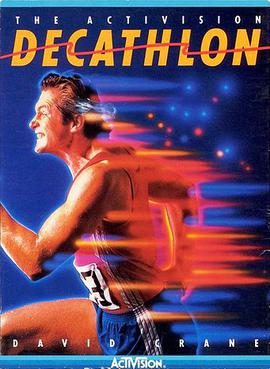
The Activision Decathlon is a sports video game written by David Crane for the Atari 2600 and published by Activision in 1983. It was ported to the Atari 8-bit computers, Atari 5200, Commodore 64, ColecoVision, and MSX. Up to four players compete in the ten different events of a real-life decathlon, either in sequence or individually.
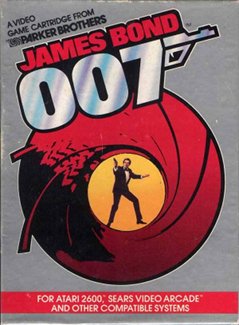
James Bond 007 is a horizontally scrolling shooter published in 1984 by Parker Brothers for the Atari 2600, Atari 5200, Atari 8-bit computers, Commodore 64, and ColecoVision. It was developed and published in Japan by Tsukuda Original for the SG-1000 under the title 007 James Bond. It was the first video game based on James Bond to be given a worldwide release.

Zenji is a puzzle video game designed by Matthew Hubbard and published by Activision in 1984. It was released for the Atari 5200, Atari 8-bit computers, ColecoVision, Commodore 64, MSX, and ZX Spectrum. Hubbard previously wrote Dolphin for the Atari 2600.

Jumpman Junior is a platform game written by Randy Glover and published by Epyx in 1983 for the Atari 8-bit computers and Commodore 64. In 1984, a port was released for ColecoVision in Australia, France, Germany, Italy and the UK. It is a follow-up to Jumpman (1983). While Jumpman has 30 levels, Jumpman Junior has 12–all of which are different from the previous game. The game was reduced in scope so it could be released in cartridge form.



















